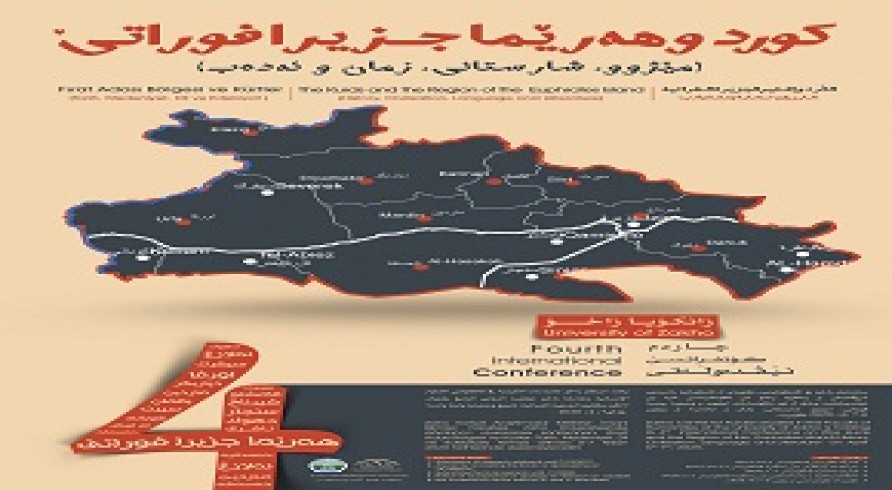

Published Date: Monday, 9 September 2019, 00:00
(History, Civilization, Language and Literature)
Zakho Center for Kurdish Studies in the Faculty of Humanities at the University of Zakho is holding its 4th International Conference on “The Kurds and the Region of the Euphrates Island: History, Civilization, Language, and Literature” on April 6-7, 2020.
• General Definition:
The region of the Euphrates Island is one of the regions characterized by an important, geographical and strategic location in Kurdistan and the Arab region. This region is characterized by its prominent presence in various eras of history, and perhaps the golden era of this region was in the ancient and medieval history (Islamic history) when some states and civilization were founded. For example, The Metan and Assyrian states were founded in the ancient history, the Hamdanids, Zangids and Ayyubids were founded in the medieval history (Islamic history). In the modern era, several Kurdish emirates were established, perhaps the most prominent and most powerful being the Bhutanese Emirate.
When looking for the history of the region in the modern era, the fate of this region is very similar to the fate of Kurdistan. It can be said that it is a miniature version of Kurdistan. Kurdistan was divided between four countries: Turkey, Iraq, Syria, and Iran although it was a unified territory within the borders of the Ottoman Empire even after the First World War.
• The Name:
This region is called the Euphrates Island, for two reasons: First: its location in the Euphrates River basin and extends its borders to the Great Zab River, one of the tributaries of the Tigris River is thus an integrated peninsula surrounded by the territory of the Euphrates River on three sides: North, West and South. Second, some people say that Euphrates has been annexed to the territory of the island in order to distinguish it from the name of the Arabian Peninsula, so this region is known as the island of the Euphrates.
• Geographical Borders and Population:
The Information about the geographical boundaries of this region is still somewhat vague. It is now known that the name of the Euphrates Island is now called the land between the province of Nineveh in Iraq and Hasakeh in Syria, but historically this region has included many areas extending from the eastern bank of the Euphrates River, In particular, from the Kobani region (Ain al-Arab) east of the Syrian-Turkish border to Albukamal on the Syrian-Iraqi border. Whereas inside Iraqi, it extends from Anah south including the provinces of Nineveh, Salah al-Din and Duhok and part of the province of Erbil, while its northern border lies within The Turkish state encompasses the areas from Schernach to the island of Bhutan, Hesenkeva, Sirte, Batman, Mardin, Alazig, Diyarbakir and Urfa to end again and meet the Syrian border on the banks of the east of the Euphrates.
Closely looking at the area of the island shows its ethnic, national, and religious diversity. Different people inhabited this region, such as Kurds, Arabs, Assyrians, Yazidis, Chaldeans, Armenians and Turkmen. Their religions are Islam, Christianity, Judaism, and Yazidism, therefore, we find a great difference between its inhabitants whether nationally, linguistically or religiously. These people have lived together peacefully as if they are of one colour, nation, and religion in spite of some convulsions of history.
• The Kurdish Part of the Euphrates Island:
The study of the history of the island of the Euphrates shows that two nationalities have controlled this region and had the upper hand in its historical events over the other nationalities in it: the Kurdish and the Arabic, and it seems that the northern half of the island is inhabited by the Kurds, and the southern half of the island is inhabited by the Arabs.
The focus of this conference will be on the Kurdish part of the Euphrates Island, which can be called the “Kurdish Island”. Its geographical borders can be determined by the line that runs from Kobani (Ain al-Arab) on the eastern bank of the Euphrates River on the Syrian-Turkish border to cover most of the Husnkifa province in Kurdistan of Syria ending in Sinjar province, and within the Iraqi borders, the borders of the Kurdish part of the Euphrates Island start from Sinjar, passing through most of the northern areas of Nineveh province to Aqra district including all the province of Duhok. Its borders in Turkey start from the Chernach region including the cities of Siirt, Batman, Bhutan Island, Husnkifa, Elazig, Diyarbakır and Urfa, and to meet again the Syrian border on the east bank of the Euphrates.
The Objectives:
The main reason for choosing the name “The Kurds and the Euphrates Island Region: history, civilization, language and literature” as the title of this conference, is due to the fact that most of the population living in the northern part of it are Kurds since ancient times, which is one of the important regions that form Kurdistan, by joining together wide strategic geographical areas. It was overpopulated throughout the history. The conference aims to shed light on the social, economic and linguistic aspects that formed the national and cultural identity of the island, and try to understand the human life on the academic bases throughout the different ages of history.
•The Vision:
The vision of this conference is to shed light on the complex aspects of the islands history, and to answer many questions to unveil the reality of life in this region, for example: What is the national composition of the island through different eras of history? What are the relationships between the people living in this region? What are the ethnic and national changes that this island has witnessed even after the First World War? How did people live with the emergence and spread of different religions and religious groups on the island? How did the policy of empires in the ancient and medieval history, and the policy of the super Powers of modern times affect the realities of life on the island and its future?
The Conference Themes:
The conference includes the following themes:
1. History
A. The Ancient History
1. The ancient history of the Euphrates Island, and what countries and empires ruled it.
2 - The ancient civilization of the Euphrates Island.
3. The religions and nationalities that emerged and lived in the ancient island of the Euphrates.
B- The Medieval History (Islamic history)
1. The Islamic conquest of the Euphrates Island.
2 - The countries and the Emirates that emerged and ruled the Euphrates Island.
3 - The role of civilization of the population of the Euphrates Island
4. The religious groups and sects on the Euphrates Island.
5. The history of the cities on the island of the Euphrates
C. Modern History
1. The Euphrates Island under the Ottomans control
2. The Kurdish Emirates that ruled the Euphrates Island
3. Life on the Euphrates Island after the fall of the Kurdish Emirates
4 - The reasons behind the division of the Euphrates Island between the three countries (Turkey, Iraq, and Syria).
Second: Kurdish Language and Literature:
The main topic of this theme is the famous Bahadinan poet :(Ahmad Nalband)
1. The development of the Kurdish language on the Euphrates Island region
2 - Kurdish literature
3. Kurdish oral folklore
4 - The influence of Kurdish on other languages on the island of Euphrates, and the influence of these languages on Kurdish
Third: Social life
This theme deals with the social life on the Euphrates Island in different eras including people, religions, clans, sects, groups, etc.
Fourth: Economic Life
1. The economy of the Euphrates Island.
2. The difference between the urban and rural economy.
3 - The development of the economy of the Euphrates Island through the ages of history.
Fifth: Cultural Life:
This theme deals with all aspects of the development of cultural life on the Euphrates Island including schools, scholars, authorship, etc.
• Abstract Submission & Guidelines:
1. Papers can be written in Kurdish, Arabic, English, and Turkish.
2- The abstract should not exceed 500 words, followed by 5 keywords.
3- Word limit should not exceed 10000 words.
4 - The following fonts are used for writing research:
For the Kurdish language (Ali-K-Sahifa), for Arabic (Ali-A-Sahifa), and for English and Turkish languages (Times New Roman).
5 – Papers are written according to Harvard methodology.
• Conference Fees:
1- Participation fees in the conference ($ 100)
2. All accommodation costs will be covered by the Conference except for travel.
• Important Dates:
1- Abstracts Submission Deadline 1/10/2019.
2- Notification of Acceptance/Rejection of the abstracts 15/10/2019.
3- Full Papers Submission Deadline 1/1/2020.
4. Notification of Acceptance/ Rejection of the full papers 1/2/2020.
5. Conference Dates April 6-7, 2020.
•Contact Address:
Correspondence should be sent to the following electronic address (hum.isc2020@uoz.edu.krd):
For more information, please call (+964 (0) 751 536 1550), and visit the following website